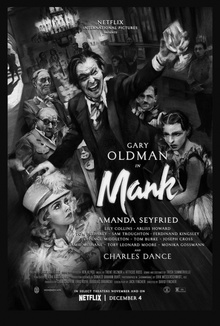
OLDMAN CHARACTER WRITES THE SCRIPT
Posted December 5th, 2020 at 9:54 pmNo Comments Yet
IN REVIEW

CHARISMATIC WRITER LEFT ON OUTSIDE BY STUDIOS
By PETER THOMAS BUSCH
Gary Oldman transforms again into a character that erases from memory all characters performed before in the biopic film about the early days of Hollywood.
Mank (2020) showcases the machinations of the film industry during an important time for the development of film.
Oldman plays Herman Mankiewicz (‘Mank’), the screenwriter who wrote the script for the film still considered one of the most important films ever produced, Citizen Kane (1941).
Director David Fincher uses the importance of the film to the film industry as a narrative device by creating a multi-layered intellectual aesthetic about a script about a script about a script.
In Citizen Kane, Mankiewicz tells a story about a newspaper baron behind which is the real life mogul William Randolf Hearst. Fincher shows how the script was developed, but he also tells the back story about where the biographical material is drawn from.
Mankiewicz attends a dinner party at Hearst’s mansion, for example, where he tells the subject matter and movie mogul, for whom he is currently employed, Louis B. Meyer, about the proposed script a few years before writing the script for RKO Radio Pictures and Orson Welles.
Fincher films in black and white, which is fitting for the time, and also because Citizen Kane was filmed in black and white.
Oldman is captured in front of the camera at various angles, showing his acting artform without the heavy make-up and facial prosthetics like he wore as British Prime Minister Winston Churchill in Darkest Hour (2017). Instead, Oldman is given a light make up touch and a hair style, as well as a few pounds in the midriff. Mank also wears a period costume that can sometimes be seen in detail, down to the texture of the suit fabric.
The film begins with Mank laid up in bed after breaking some bones in a motor vehicle accident just as he is to start his writing contract for Welles. Fincher maintains one linear narrative about the writing of the script for Citizen Kane, but then he introduces the audience to the character behind the screenwriter with an intertwining narrative.

Oldman is joined by several supporting actors. The casting is such though that Oldman’s character has been given more stature, while important biopic characters in positions of power at the time, such as Meyer, Hearst, Marian Davies, and even Welles, are almost relegated to the background.
This treatment of the cast allows Oldman to perform a character study in the context of the film industry dominated by the studio system.
Oldman takes on the image of the stereotypical alcoholic, washed up writer who to his own surprise writes his best work to date.
Oldman developed not only the persona of a studio writer, but the voice and drunken swagger of a writer that might not be as important to the studios as he may think.
In one scene, Mank attends the filming of a movie, where Meyer is also in attendance. Mank is well known to everyone except the owner of the studio.
Fincher explains how film scripts were developed by the studios in teams of writers. And so credit for the script often passed on to someone else.
Mank and Welles get into a dispute over credit given to the Citizen Kane script. In the end, both writers shared the Oscar that year for Best Writing, Original Screenplay. The studio ownership of the material, and everyone being replaceable, is underscored by Fincher.
Fincher also puts the production of Citizen Kane in context by explaining the divided nation during the Great Depression. America was a market economy that discouraged government intervention. But the problems of high unemployment and low consumer demand seemed unsolvable until the government took up stewardship of the faltering economy.
Fincher also uses a film score in the Classic Hollywood style when dialogue and action were still being developed.
Casting does a good job to get biopic lookalikes. Hearst is played by Charles Dance. Dance has recently also been cast in the Netflix Series the Crown (2019) as Lord Mountbatten, starring Olivia Colman, and in the Amazon Prime Video series, The Widow (2019), starring Kate Beckinsale.
Amanda Seyfried is cast well as Hearst’s mistress, Marion Davies. Seyfried shares significant screen time with Oldman since Davies and Mank had a platonic relationship as Mank tried everything to make his way to the next film project before getting fired again.
Davies was a screen actor with a sophisticated edge that made her alluring to Hearst, who was the newspaper mogul of the time.
Seyfried previously played Cosette in the remake of Les Miserables (2012).
Fincher supports Oldman with all these film elements at the narrative center as Oldman subtly develops, from scene to scene, the charismatic writer personality, eventually showing up late to dinner parties, drunk and unabashedly quick to become the life of the party.
Mank is a Netflix Original film.